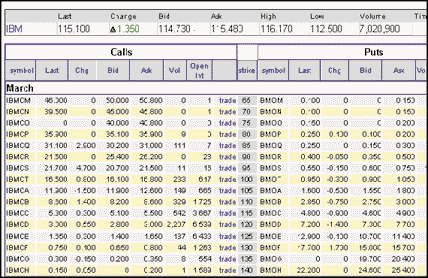OPTIONS
Limited Risk With Limited Profit
Option Credit Spreads
by Lee Lowell
Selling options is usually a good idea. Here's a tactic to do it.
Option trading all comes down to probability of profit. Statistically, option sellers always have a better chance of profiting. It's true that when you sell options your profit is limited, but your chances of walking away with that profit are high. The reverse is true for option buyers. Their potential profit is limitless, but the odds of achieving that profit are very small, especially with out-of-the-money options.

FIGURE 1: OPTION CHAIN. Options Express, one of many options brokers, provides a full list of market pricing for just about any credit spread.
Why not put the odds of success on your side and learn how to become a
smart option seller? Naked (uncovered) option selling entails unlimited
risk and limited profit, but there is a strategy of option selling that
has limited risk as well as limited profit. It's called a credit spread.
HOW CREDIT SPREADS WORK
In a credit spread, you sell an option and buy a cheaper option at the same time to limit your risk. Since you are selling a more expensive option than you are buying, you get to take an initial credit into your account. As long as you implement the trade as a spread, you will never be exposed to unlimited loss, as is the case with naked option selling.
Credit spreads come in two types -- the bear call spread and the bull put spread. A credit spread is always used with either all calls or all puts and within the same expiration month. A call credit spread consists of selling a more-expensive, lower-strike call (say, a 100 call for $5), and buying a less-expensive, higher-strike call (such as a 105 call for $2). A bull put spread consists of selling a more-expensive, higher-strike put (a $100 put for $5) and buying a less-expensive, lower-strike put ($95 put for $2). In both examples, your net credit is $5 - $2 = $3 per contract.
The best outcome of a credit spread is to have all the strikes expire worthless so you can keep the entire premium you collected at the beginning. Credit spreads should be initiated using the two closest months to expiration. This is when time decay starts to accelerate, and it gives the underlying security less chance to make a move against the position.
Credit spreads can be used with individual stocks, futures options, or indices such as the OEX, QQQ, Standard & Poor's 500, and so on. If you are playing the stock market, credit spreads are preferable with an index such as the OEX or SPX options because there's less chance of a gap move than there is with many individual stocks.
Credit spread trading is a simple, safe, and stress-free type of trade that does not require a great deal of monitoring. You just place the trade, collect the credit, and wait for the options premiums to decrease or expire worthless. And if the underlying security starts to move against your position, there's no need to worry; your loss is limited, no matter how far the security might move. Plus, you can always unwind the spread at a small loss before expiration occurs. ...Continued in the May 2001 issue of Technical Analysis of STOCKS & COMMODITIES
Lee Lowell is a former New York Mercantile Exchange (NYMEX) options pit trader. He continues to trade energy and other derivative options from his home office in Hawaii. He can be reached via e-mail at syd697@hsa-kauai.net.
Excerpted from an article originally published in the May 2001 issue of Technical Analysis of STOCKS & COMMODITIES magazine. All rights reserved. © Copyright 2001, Technical Analysis, Inc.
Return to May 2001 Contents